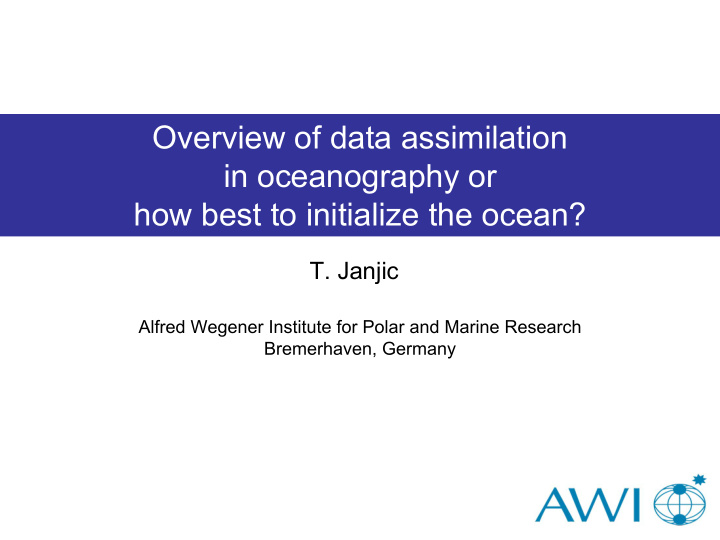



Overview of data assimilation in oceanography or how best to initialize the ocean? T. Janjic Alfred Wegener Institute for Polar and Marine Research Bremerhaven, Germany
Outline • Ocean observing system • Ocean models • Data assimilation techniques • Reanalysis products • Coupled atmospheric ocean data assimilation
Ocean observing system • Increase in near real data availability since end of nineties • Primarily source of information are satellite data • SST (AVHRR), Salinity (SMOS), Dynamical ocean topography, sea-ice data (ENVISAT, CRYOSAT, …) • Satellite products are used for IFREMER / CERSAT assimilation. Mission Cycles repeat period data source (day) Jason1 70-113 10 GDR-C CNES/NASA T/P 413-456 10 MGDR-B / NASA ENVISAT 23-34 35 GDR / CERSAT Launched March 17, GFO 120-145 17 GDR / NOAA 2009
Ocean observing system Other data used for assimilation are: •Surface drifters measuring velocity, temperature, salinity •Hydrographic sections data •Besides surface data only substantial data set that measures temperature and salinity up to 2000m are ARGO floats ARGO float distribution April 2008 •Some regions are observed more for example tropical oceans Ocean still underobserved especially •Generally polar regions are not subsurface ocean variables! well observed
Weddell Sea WOCE: CTD-stations WOCE: CTD-stations winter < 300 CTD casts 1100 CTD casts AWI floats AWI floats winter 7000 float profiles >3000 float profiles
Floats are free drifting underwater buoys. Their compressibility is less than or equal to seawater and, hence, they gain positive buoyancy as they sink. For this reason, float pressure cases are often made of aluminum or glass. At a certain depth, the buoyancy force acting on the pressure case equilibrates with the weight of the float and it stops sinking. This physical concept, called neutral buoyancy, is the basis of floats.
Ocean models • Solve the standard set of hydrostatic ocean dynamics primitive equations • For forcing daily atmospheric ECMWF or NCEP data are used • Sources of uncertainty: representation of Representation of topography is topography, forcing, resolution and one of uncertainty in ocean parametrizations modeling • Low resolution models can not represent Data assimilation one way of well location of the Gulf Stream for example. controlling model bias! To improve this density in some models is corrected with density from climatology.
Sequential data assimilation algorithms observation available at t k forecast error covariance matrix is time evolving error covariance matrix derived from ensemble of model states, multivariate, nonstationary, nonisotropic. observational error covariance matrix Possible approximations to are instead of ensemble derived, also a stationary in time covariance (full or reduced rank).
Data assimilation • Alternative technique 4D-Var (for example ECCO) • This technique also requires specification of the errors in terms of covariance. • Initially temperature and salinity are usually corrected and forcing through time (Note the fluxes obtained are the best fluxes for Example of ability to improve the ocean model corrections. Not necessarily the best fluxes for use the forecast by applying in atmosphere.) ensemble based Kalman filter algorithm for assimilation of sea surface temperature into • Computationally more expensive regional ocean model for North then Kalman filter methods and Baltic Sea. (Loza et al.)
Monthly RMS error compared to ARGO 0 m 0 m 1700 m 1700 m RMS errors for every month of 2004 for South Atlantic (left) and for South Indian Ocean (right), at level 0 (upper panels) and at level 1700 (lower panels). The results of experiments 5TH (black line), 5THplTS (dashed black line), for model run without data assimilation (red line) and climatology (dashed blue line) are shown. Note the different scale in upper and lower panels.
Ocean reanalysis Ocean reanalysis are also available. For example SODA and GECCO efforts are compared here. SODA GECCO • 1958-2001 • 1952-2001 • Daily surface winds from ERA • NCEP/NCAR reanalysis MIT 1 o global model 40 • POP 0.25 o 0.4 o • • 23 levels • 40 levels • Variational data assimilation • Sequential OI method SODA in contrast to GECCO does not use any altimetry measurements. Besides in-situ measurements nighttime SST from AVHRR is assimilated in both products.
RMS sea level variability showing the mean position of the Gulf Stream as well as details such as Gulf of Mexico Ring formation .
Coupled ocean atmosphere data assimilation • Techniques for coupled ocean atmosphere data assimilation are currently under development • It is expected that assimilation of both atmosphere and ocean simutaniosly would produce the best results • However, first assimilation is done separately for ocean and for atmosphere Only in forecasting step these are coupled.
Conclusion • Better understanding of oceans plays a critical role in setting the rate and nature of global climate variability, e.g. heat budget, freshwater budget, carbon budget • Compared to atmospheric data assimilation where data are in abundance, ocean data assimilation is characterized with sparse observations • Ocean observations cover surface but very poorly deeper ocean. • In addition primarily satellite derived products are assimilated • Bias in ocean models is still a major problem
Conclusion • By data assimilation we can try to reduce the negative impact of biases in model representations of atmospheric and oceanic processes • Develop tools to facilitate model-observations comparisons. This is complicated in oceanography since there is still no operational oceanography • Develop fully-coupled data assimilation schemes • Develop proper estimates of model and data uncertainties
Recommend
More recommend